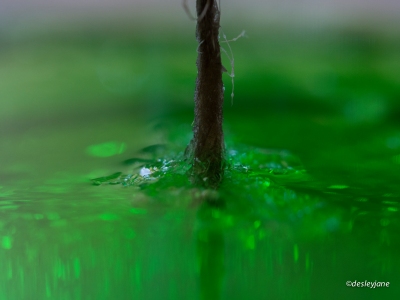For this week’s Scientific Reasoning, I want to talk to you about growing crystals. It seems fitting since last week’s feature was an Interview with Dr Julia Archbold who worked with protein crystals.
I work with some scientists who are protein crystallographers. These talented individuals isolate a particular protein and then work out how to grow it in crystal form. Once they’ve grown the crystals, they’re able to use x-ray beams to determine the structure of that protein. This gives the scientists a lot of information about how that protein works in the body, and how it interacts with other proteins and molecules. This is very important for studying diseases, how they work and how to treat and cure them.
Today’s experiment is to grow some crystals of our own. I’m going to show you how to grow sugar crystals, but you can also grow salt crystals as well using the same method. Sugar gives you bigger crystals that are easier to see. This experiment is not a quick one. It’s quite quick to set up, but the crystals take a few days to fully form. I actually left this one working away for a few weeks, I was fascinated with the crystal structures and (you know me!) photographing them as often as I could.
What will you need?

- 1 cup water
- 3 cups table sugar
- food colouring (if you want)
- clean glass jar
- pencil
- string (hairy string is best – mine is jute string)
- saucepan to boil water
- spoon
What will you do?
- In the saucepan, start boiling the water.
- Stir in the sugar, one spoonful at a time. The idea is to dissolve as much sugar as possible in the water. As soon as no more will dissolve, stop adding. There should be no undissolved sugar in the pan. This is the most difficult part of the process to get right.
- Add a few drops of food colouring if you wish, and stir through.
- Tie the string to the centre of the pencil – the string should be able to reach into the liquid but not touch the bottom.
- Let the sugar solution cool slightly, then dip the string into the solution to wet it and take it out again.
- Carefully pour the solution into the clean glass jar.
- Place the pencil on top of the jar. I taped the pencil into place. Remember that the string should dip into the solution but not touch the bottom of the jar.
- Place the jar somewhere that it won’t get bumped, but where you and the children can check on it daily.
- Enjoy! This is one experiment that you CAN eat 🙂
What will you learn?
- As the water evaporates from the string, tiny sugar crystals will form on the string. The tiny crystals then provide a surface for growing more crystals (this is called seeding).
- By dissolving sugar in hot water until no more will dissolve, you have created a super-saturated solution. Hot water can hold more sugar than cold water. As it cools, the solution can’t hold the same amount of sugar anymore, so it has to come out of the solution and it forms crystals. This process is called precipitation (just like rain, only in this case, it’s a solid).
- On the other hand, as time passes, the water starts to evaporate. The sugar does not evaporate, so instead the remaining solution gets more and more concentrated in terms of sugar content. As we now know, the water can’t hold any more sugar, so if there’s less water, the sugar has to come out of solution (or precipitate).
Some tips.
- This should be done slowly. The slower the better – this causes larger crystals to grow, so they’re easier to see. If you quickly cool the solution in the fridge, the crystals will be much smaller.
- It’s best not to boil the sugar, if it gets too hot, then it might form a soft toffee – this happened to mine the first time, so I had to add more water and warm it again to dissolve the toffee. I also poured some into patty papers to eat later 🙂
- Did you know that brown sugar is just white sugar that hasn’t been fully purified? There are still some impurities in the sugar, which gives it its colour. If you use brown sugar, this experiment probably won’t work.
- If you can’t see any crystals growing on the string after 24 hours, pop the solution back in the saucepan and bring it to the boil, then pour it back into a clean jar.
- The jar needs to be clean. Crystals like to grow on something that is already there – that’s why we’re using the hairy string. If there is dirt in the jar, the crystals will probably grow on the dirt and not up the string. The dirt acts as a “seed” for the crystals to grow on.
x desleyjane
Safety Considerations.
- Boiling water should be handled by an adult.
- Once the sugar is dissolved, it will be extremely hot. I recommend not letting the children near it until it cools.
















I’d love to hear from you!